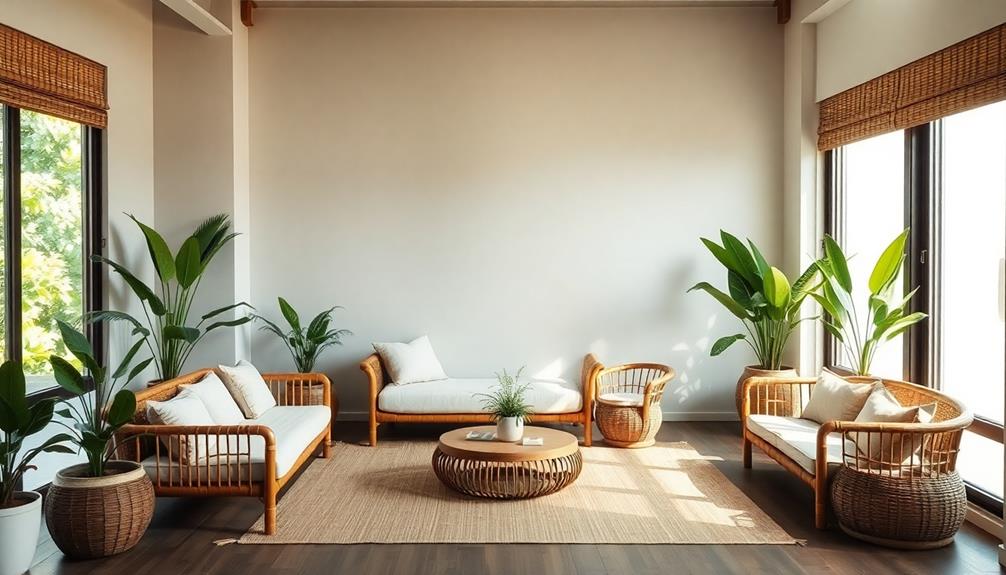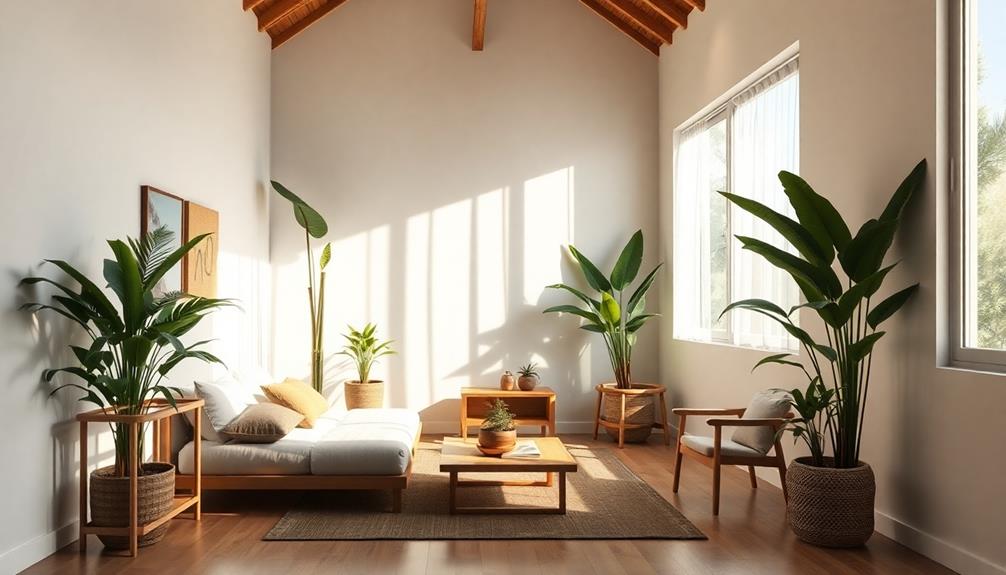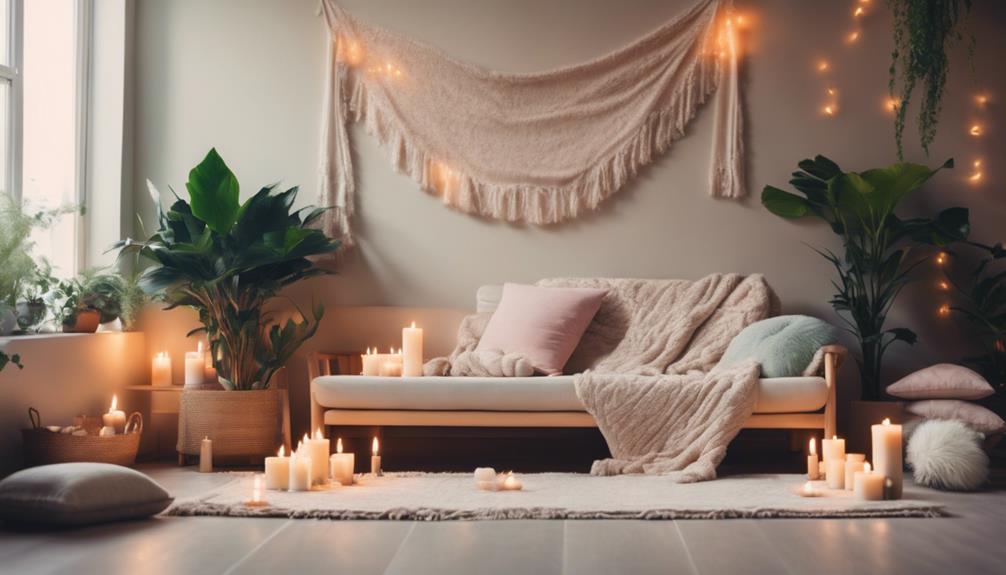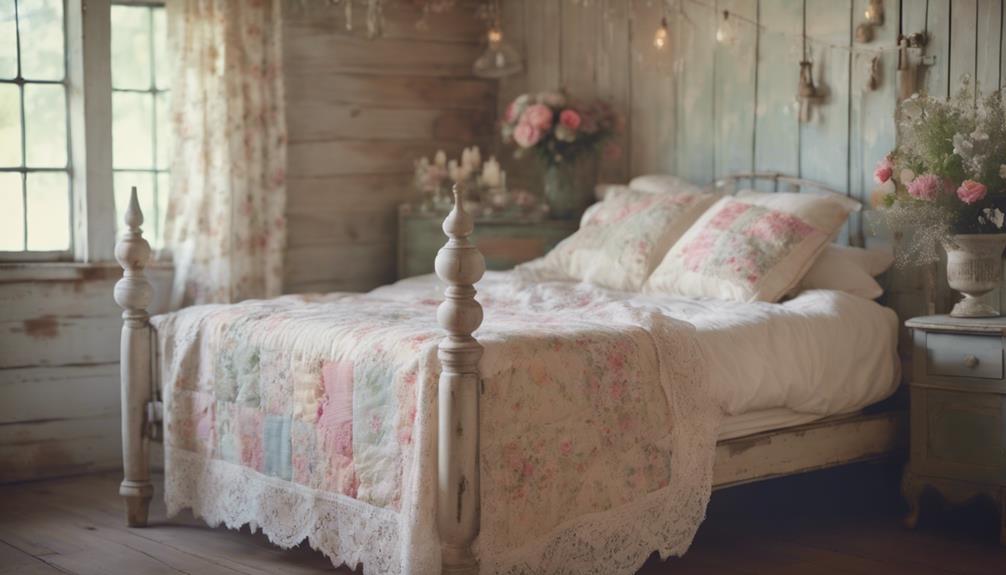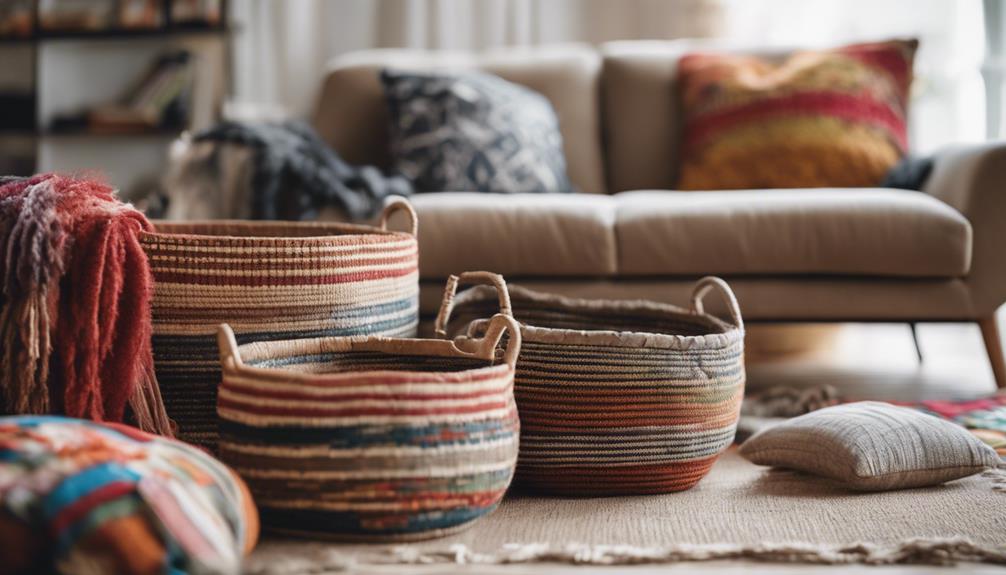Exploring minimalist Indonesian design for small spaces lets you embrace functionality and sustainability. You'll find options like the Putih Tiny Villa that blend luxury with eco-friendly materials. Neutral colors and natural textures create serene environments, while open layouts promote natural light and airflow. Multi-functional furniture, like a foldable table or storage coffee table, optimizes space without sacrificing style. Incorporating local craftsmanship into your home adds a unique charm. This design approach makes your limited space feel expansive and inviting. Want to discover even more ideas to enhance your small living area? There's plenty more to explore.
Key Takeaways
- Minimalist Indonesian design emphasizes sustainability and luxury, ideal for small spaces through the use of natural materials and open layouts.
- Flexible layouts and multi-functional areas optimize space utilization, making living environments comfortable and functional.
- Neutral color palettes and sleek lines promote tranquility and amplify natural light, enhancing the overall ambiance of compact areas.
- Eco-friendly building practices such as bamboo use and natural ventilation reduce energy consumption while promoting a healthy living environment.
- Harmonious indoor-outdoor spaces integrate cultural elements, creating serene areas that extend functional living space and enhance residents' connection to nature.
Putih Tiny Villa in Bali

Have you ever envisioned a space that perfectly blends luxury with sustainability? The Putih Tiny Villa in Bali does just that. Designed by Balitecture, this exquisite villa showcases minimalist design principles that maximize functionality without sacrificing beauty.
As you step inside, you'll notice the clever use of neutral colors, creating a serene living space that feels both expansive and intimate. The villa incorporates elements that emphasize natural materials and open spaces, reflecting Balinese design characteristics that enhance social interaction and relaxation.
The villa's layout is flexible, allowing you to adapt the space to your needs while maintaining a connection between indoor and outdoor environments. Natural light floods the interior, enhancing the tranquil atmosphere and providing stunning views of the surrounding landscape.
You'll appreciate the incorporation of local materials and craftsmanship, which not only adds to the villa's aesthetic appeal but also roots it in cultural authenticity.
In this small space, you can embrace a lifestyle that prioritizes both luxury and environmental responsibility. The Putih Tiny Villa serves as a model for anyone looking to create a harmonious living environment that reflects modern minimalism.
With its thoughtful design, you can truly enjoy a balance of comfort and sustainability.
Affordable Villa in Kecamatan Mengwi
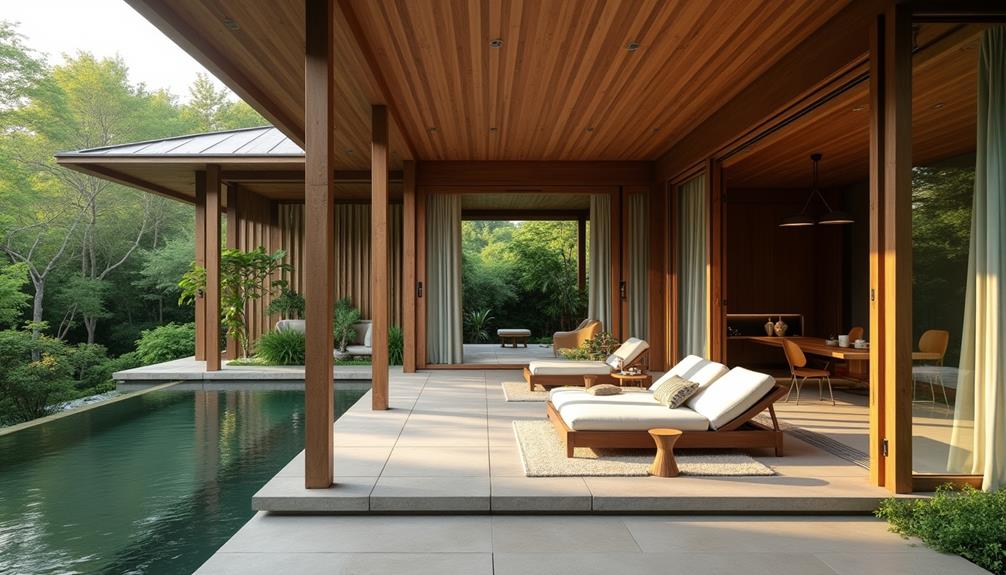
If you're looking for an affordable yet comfortable option in Bali, the villa in Kecamatan Mengwi offers a perfect solution. Priced at just $208 per night, this cozy one-bedroom setup features an ensuite bathroom and an enclosed living area designed for convenience.
You'll appreciate the kitchenette, allowing you to prepare meals and enjoy a homely atmosphere during your stay. The villa's decor may also include Indonesian decorative pillows that enhance the living spaces with vibrant colors and intricate patterns, creating a warm and inviting environment.
The villa embraces minimalist Indonesian design with elements of Japanese design, creating a serene and practical environment. The layout maximizes available space, ensuring you feel both comfortable and relaxed.
The living room serves as a multifunctional area, perfect for unwinding after a day of exploration or hosting a small gathering. A stylish coffee table can be the centerpiece here, encouraging conversations while sipping your favorite drink.
This affordable villa strikes an ideal balance between luxury and budget-friendly accommodations, making it perfect for travelers who want to experience the beauty of Bali without overspending.
Nestled in a tranquil setting, you'll find it easy to recharge and enjoy the island's charm. Don't miss out on this gem that caters to your comfort and wallet!
Tropical Villa Designs in Bali
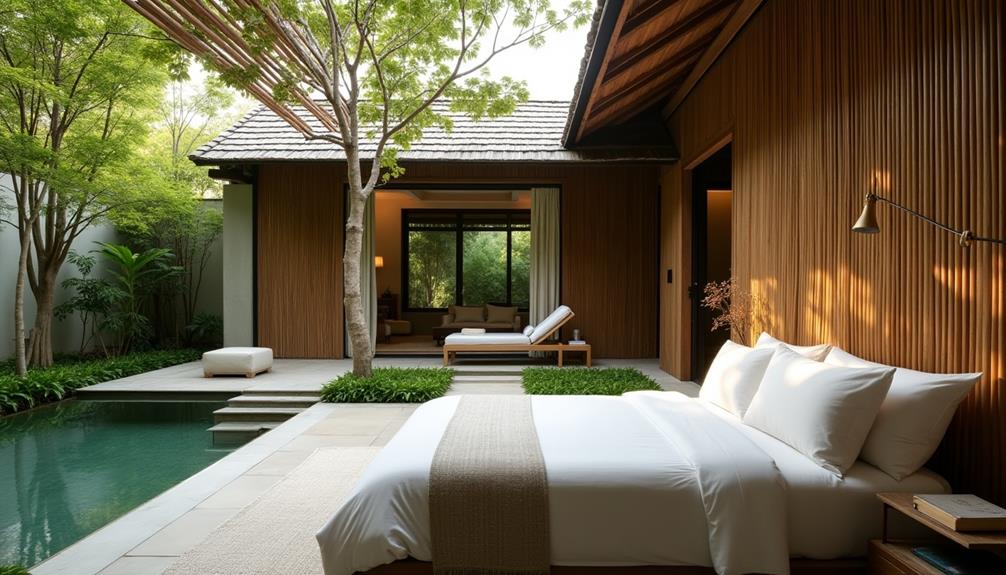
Tropical villa designs in Bali showcase an impressive blend of open layouts and abundant natural light, creating a harmonious indoor-outdoor living experience.
You'll notice how these designs often use simple lines that enhance the overall aesthetic, making the space feel airy and inviting. Each villa becomes a focal point of relaxation, with elements like private gardens and swimming pools that encourage leisure.
These designs often incorporate traditional Indonesian style home decor, emphasizing harmony with nature and utilizing natural materials for added warmth and character traditional Indonesian style home decor.
Innovative architectural approaches, such as those found in the Putih Tiny Villa, maximize limited footprints while combining luxury with sustainability.
By incorporating local materials and craftsmanship, these villas not only reflect Bali's rich cultural heritage but also support the local economy.
Affordable options, especially in Kecamatan Mengwi, prove that you don't have to sacrifice comfort for design.
Many of these villas feature multi-functional spaces that cater to your needs, ensuring every corner of the room serves a purpose. Spacious terraces offer stunning views, enhancing your connection to the natural surroundings.
In Bali, the tropical villa designs create a unique feel to the room, encouraging a lifestyle that embraces both relaxation and sophistication.
You'll find that each detail contributes to a seamless blend of comfort and elegance.
Unique Architectural Styles
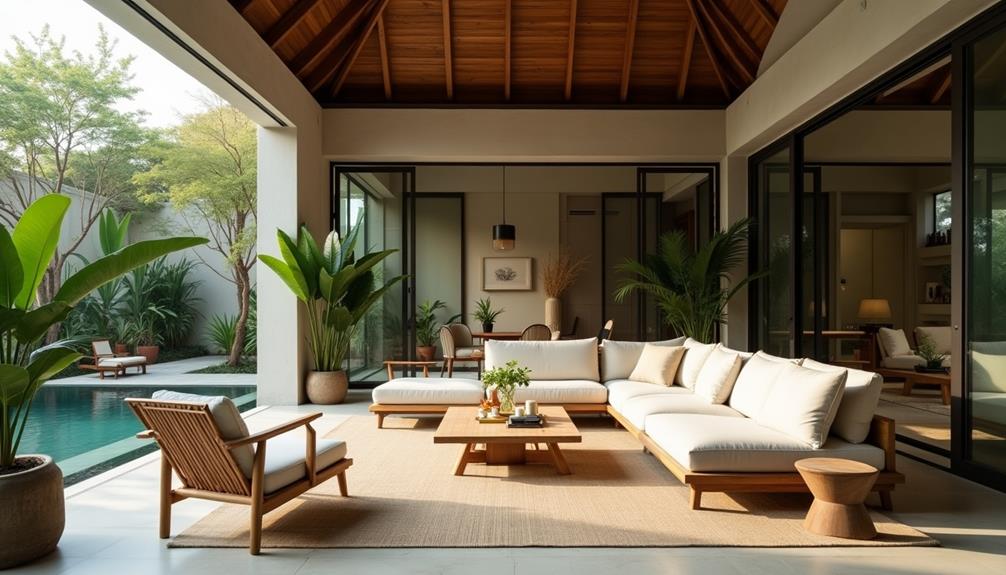
When you explore unique architectural styles in Indonesian design, you'll notice how cultural influences shape every detail.
These homes often embrace eco-friendly building practices that not only respect the environment but also optimize space effectively.
Cultural Design Influences
Indonesian house design captivates with its unique cultural elements that reflect the rich local heritage and climate. You'll notice that these homes often emphasize functionality alongside aesthetics, making them perfect for small spaces. For example, Rumah Bali minimalis focuses on simplicity and functionality, featuring clean lines and open layouts that promote tranquility.
Here's a quick overview of some cultural influences in Indonesian design:
| Design Style | Key Features | Cultural Significance |
|---|---|---|
| Tropical Houses | Natural ventilation, local materials | Adapts to climate, creates harmony |
| Modern Bahay Kubo | Blend of traditional and contemporary | Versatile, sustainable living |
| Rumah Bali Minimalis | Simple, functional, open layouts | Reflects local heritage and tranquility |
In Bali, tropical houses emphasize natural aesthetics, showcasing local craftsmanship and materials that foster a connection with nature. This approach not only enhances the living experience but also respects the environment. By embracing these unique architectural styles, you're not just creating a home; you're celebrating Indonesia's rich cultural landscape.
Eco-Friendly Building Practices
Emphasizing eco-friendly building practices, unique architectural styles in Indonesia harmonize with the environment while showcasing local materials and craftsmanship. You'll find that many designs utilize bamboo and reclaimed wood, promoting sustainability and reflecting the rich cultural heritage. This traditional Indonesian housing not only reduces environmental impact but also preserves traditional methods.
In small tropical homes, natural ventilation and light are emphasized, which greatly cuts down the need for artificial cooling. This design choice enhances energy efficiency, making your living space comfortable without excessive energy use. One such innovative style is the Rumah Bali minimalis, which prioritizes simplicity and functionality, allowing for efficient use of limited space.
Moreover, integrating traditional craftsmanship with modern sustainable practices creates unique structures that blend seamlessly into their surroundings. Many designers incorporate green roofs and rainwater harvesting systems, further promoting sustainable living.
Space Optimization Techniques
Many innovative architectural styles in Indonesia focus on maximizing limited space, making them perfect for small living environments. You'll find that designs like the Putih Tiny Villa in Bali cleverly blend indoor and outdoor areas, creating flexible layouts that enhance your living experience.
Here's a quick overview of key space optimization techniques:
| Technique | Description | Benefits |
|---|---|---|
| Flexible Layouts | Spaces that can adapt to various activities | Maximizes usability |
| Eco-Friendly Materials | Use of local, sustainable resources | Reduces environmental impact |
| Natural Ventilation | Open designs that promote airflow | Improves comfort and freshness |
| Multi-Functional Areas | Rooms serving multiple purposes | Saves space and enhances utility |
| Artisanal Craftsmanship | Clean lines and skilled woodworking | Adds aesthetic appeal and durability |
Small Tropical House Inspirations
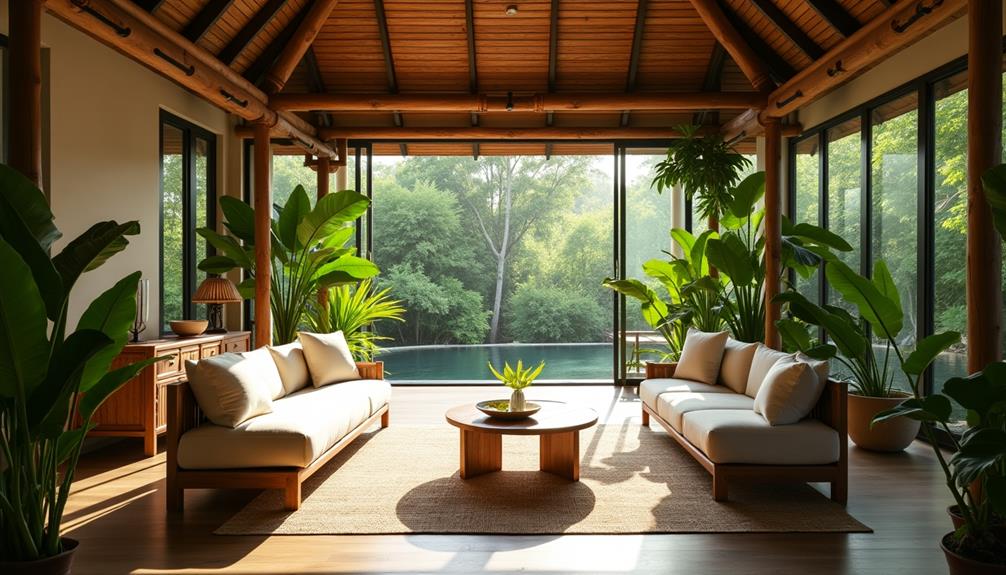
When it comes to small tropical house inspirations, you'll find that these designs beautifully blend functionality with nature.
Indonesian architecture emphasizes eco-friendly practices, guaranteeing your home is sustainable even in limited spaces. Incorporating elements like a Face Indonesian Decor Mask can enhance the aesthetic while celebrating cultural heritage. You can enjoy a comfortable living environment without excessive energy use by incorporating natural ventilation and light.
Here are four features that make these homes stand out:
- Open Layouts: These designs prioritize open spaces, maximizing functionality while allowing you to stay connected to the lush surroundings.
- Local Materials: Using locally sourced materials not only enhances the aesthetic appeal but also supports the local economy and craftsmanship, giving your home a unique character.
- Natural Ventilation: Thoughtful placement of windows and openings guarantees fresh air flows through, keeping your space cool and comfortable.
- Traditional Elements: Many designs embrace traditional Indonesian features, creating a harmonious blend of modernity and heritage that resonates with the tropical landscape.
With these inspirations, you can create a small tropical house that's both practical and inviting, perfect for enjoying life in harmony with nature.
Aesthetic Design Concepts
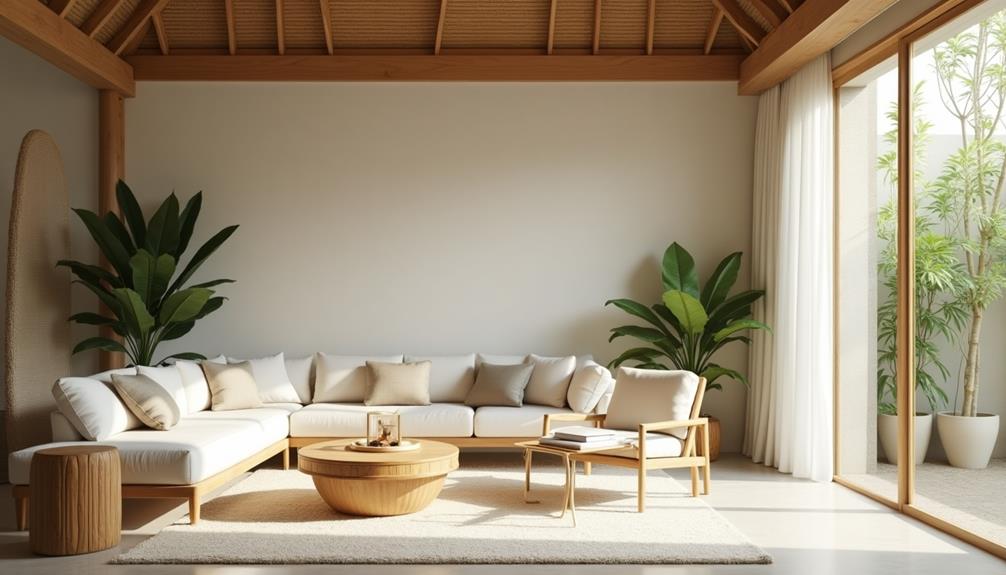
Minimalist Indonesian design concepts elevate small spaces by focusing on harmony and simplicity. By using natural materials, especially local woods, you can create a warm and inviting atmosphere. The integration of Indonesian woodcraft with Japanese and Korean design principles results in sleek lines and functional elegance that enhance your space.
Rich textures and artisanal details in furniture and decor add tranquility, making compact areas feel more spacious. Neutral color palettes promote calmness, allowing natural light to amplify the overall aesthetic. You can foster a unique yet cohesive living environment by incorporating handcrafted elements and minimalistic decor.
Here's a quick overview of key aesthetic elements:
| Element | Description |
|---|---|
| Natural Materials | Emphasizes local woods for warmth |
| Sleek Lines | Blends Indonesian, Japanese, and Korean styles |
| Rich Textures | Adds artisanal detail for tranquility |
| Neutral Color Palettes | Promotes calmness and spaciousness |
| Handcrafted Elements | Creates a unique, cohesive feel |
Harmonious Indoor-Outdoor Spaces
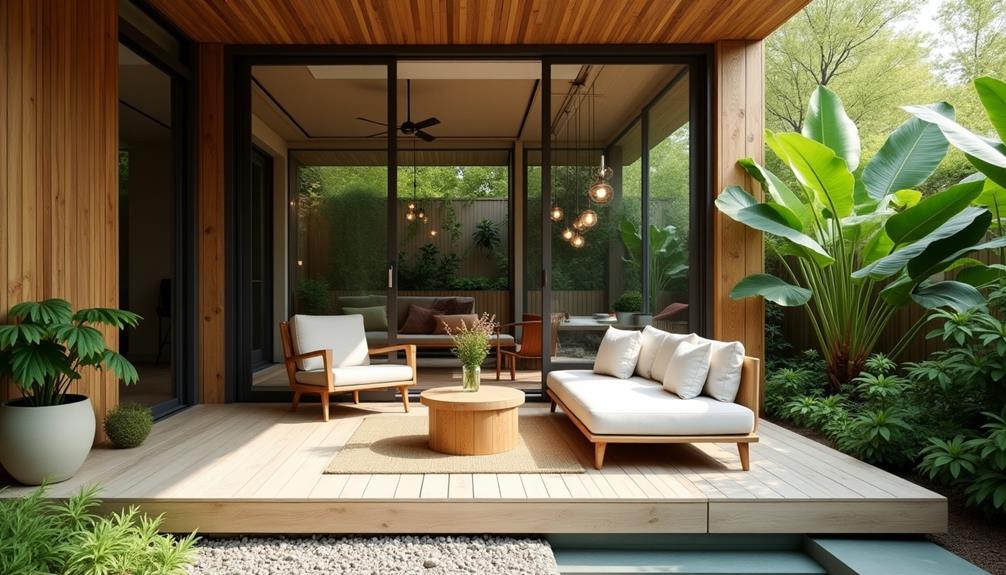
Harmony in design creates a seamless flow between indoor and outdoor spaces, enhancing your living experience.
Embracing minimalist Indonesian design principles allows you to transform your small space into a tranquil retreat where nature and home coexist beautifully. Incorporating elements such as Indonesian decor masks can further enrich the ambiance, adding a cultural touch that resonates with storytelling and artistry.
Here are some key elements to reflect upon:
- Natural Materials: Use wood and stone to foster a connection with the outdoors, enhancing warmth and comfort within your home.
- Open Layouts: Opt for an open floor plan that invites natural light and ventilation, making your indoor space feel expansive and airy.
- Serene Outdoor Areas: Create an outdoor oasis with wooden decking and stylish furniture, extending your functional living space beyond walls.
- Cohesive Aesthetics: Integrate elements like Japanese lanterns and Korean planters in your outdoor design to blend cultural influences with the natural environment.
Functional Living Areas
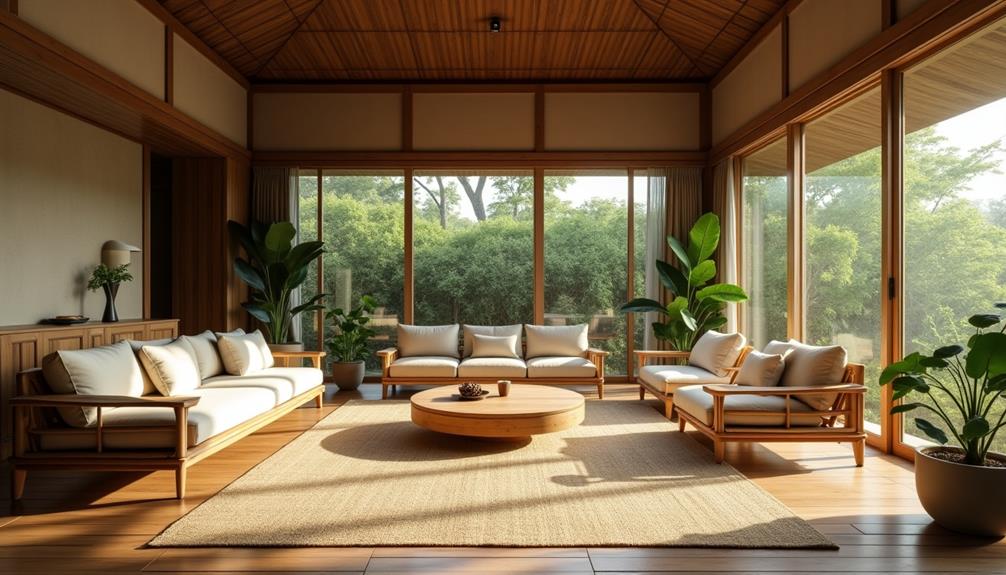
In minimalist Indonesian design, functional living areas focus on efficient space utilization and versatile multi-functional designs to maximize your small space.
This approach often incorporates elements of luxury tropical design aesthetics that blend natural materials with modern simplicity, creating a serene atmosphere.
You'll find cozy interiors that blend comfort with simplicity, using smart storage solutions to keep everything organized.
This approach not only enhances your living experience but also creates a tranquil environment you can truly enjoy.
Efficient Space Utilization
Efficient space utilization in Indonesian design transforms small living areas into multifunctional havens. By embracing this approach, you can enhance practicality and comfort in your home, much like the principles found in tropical villa plans that focus on open spaces and natural light.
Here are four key elements that help maximize your space:
- Multifunctional Areas: Each room can serve multiple purposes. For instance, a living room can also act as a workspace or guest area, making it incredibly versatile.
- Wooden Cabinetry: In the kitchen, Indonesian wooden cabinetry merges artistry with modern appliances, providing ample storage without overwhelming the space. This keeps your kitchen organized and stylish.
- Open Shelving: Minimalistic decor and open shelving in kitchens allow easy access to essentials while maintaining a clean aesthetic. This simplicity reinforces the minimalist design you're aiming for.
- Natural Wood Elements: In bathrooms, incorporating natural wood elements like teak shower benches not only enhances the calming atmosphere but also maximizes limited square footage, ensuring every inch counts.
Versatile Multi-Functional Designs
Creating versatile multi-functional designs in small spaces is essential for maximizing comfort and usability. By incorporating Indonesian wooden cabinetry and furniture, you can enhance storage without compromising on aesthetics. Open shelving in kitchens and living areas not only showcases a contemporary look but also offers practical access to kitchenware and decorative items.
Moreover, integrating Korean organizational solutions, like sleek nightstands and minimalist storage, keeps your space uncluttered while enhancing the overall design. Multi-functional furniture, such as foldable tables and convertible sofas, offers flexibility, accommodating various activities and gatherings within limited square footage.
Here's a quick overview of how these elements work together:
| Design Element | Functionality | Aesthetic Appeal |
|---|---|---|
| Indonesian cabinetry | Maximizes storage | Rich wooden texture |
| Open shelving | Easy access to items | Contemporary showcase |
| Multi-functional furniture | Adapts to various activities | Sleek, minimalist design |
| Korean organizational solutions | Keeps space uncluttered | Streamlined look |
| Natural wood elements | Creates calming ambiance | Warm, inviting atmosphere |
Cozy Minimalist Interiors
Embrace the charm of cozy minimalist interiors by designing functional living areas that prioritize both comfort and efficiency.
In your small space, you can create an inviting atmosphere while maintaining a clean aesthetic. By incorporating elements of modern tropical aesthetics, you can seamlessly blend your indoor and outdoor environments.
Here are four key elements to contemplate:
- Multifunctional Furniture: Choose pieces that serve dual purposes, like a coffee table that doubles as storage or a sofa bed for guests.
- Natural Materials: Incorporate locally sourced wood and natural fibers to warm up your space. These materials not only add texture but also connect you to the environment.
- Light and Open Layouts: Maximize natural light by using sheer curtains and maintaining an open flow. This approach creates a serene atmosphere that feels larger and more inviting.
- Thoughtful Decor: Use neutral color palettes and handcrafted accents that reflect Indonesian craftsmanship. This thoughtful decor enhances tranquility and adds character without overwhelming your space.
Serene Bedroom Atmospheres
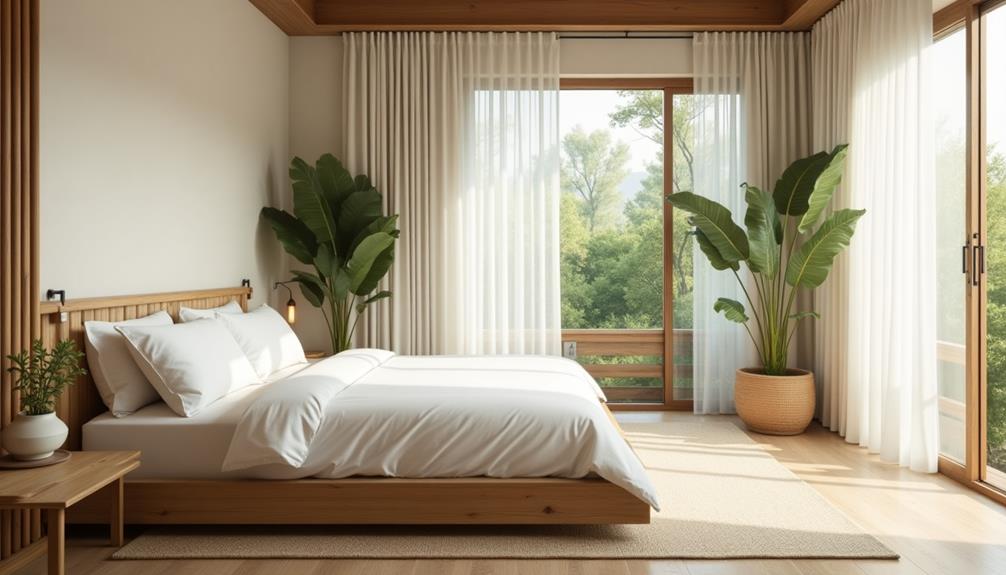
A serene bedroom atmosphere invites tranquility and restful sleep, making it essential for personal well-being. To achieve this, opt for muted tones in your bedding and pillows. Soft colors create a calming environment, promoting relaxation.
Incorporating sleek nightstands and functional storage solutions inspired by Korean minimalism helps maintain an uncluttered space, essential for a peaceful retreat. Additionally, consider accentuating your space with unique elements like traditional artistry through Indonesian decor masks that contribute to the overall aesthetic.
Choose low-profile furniture and delicate lighting elements that reflect Japanese design principles. These features enhance the serene aesthetic of your bedroom, allowing you to unwind fully.
Aim for a harmonious blend of comfort and style by selecting furnishings that showcase artisanal craftsmanship while keeping the overall design simple and elegant.
Utilize natural materials like wood and cotton to foster a warm texture, creating a peaceful ambiance conducive to restful sleep. This retreat-like environment encourages you to disconnect from daily stresses and reconnect with yourself.
Frequently Asked Questions
What Are the Key Elements of Minimalist Indonesian Design?
When considering key elements of minimalist Indonesian design, focus on simplicity, natural materials, and functionality. You'll appreciate clean lines, open spaces, and earthy colors that create a harmonious environment, promoting tranquility and connection with nature.
How Can I Incorporate Indonesian Textiles in Small Spaces?
Imagine transforming your living room with a Batik throw pillow. You can incorporate Indonesian textiles by using vibrant fabrics for cushions, wall hangings, or even table runners, adding color and texture without overwhelming the space.
What Types of Wood Are Commonly Used in Indonesian Furniture?
In Indonesian furniture, you'll commonly find teak, mahogany, and rubberwood. Each type offers unique durability and aesthetic appeal, making them ideal for both traditional and modern designs. You'll love how they enhance your space!
How to Achieve Balance in a Minimalist Indonesian Interior?
How do you create harmony in your space? To achieve balance in a minimalist Indonesian interior, focus on simplicity, natural materials, and strategic placement of furniture to enhance flow and maintain an uncluttered atmosphere.
Are There Specific Colors That Enhance Minimalist Indonesian Design?
Yes, certain colors enhance minimalist Indonesian design. You'll find that earthy tones, soft whites, and muted greens create a serene atmosphere, while natural finishes add warmth. Together, they promote harmony and simplicity in your space.
Conclusion
In exploring minimalist Indonesian design for small spaces, you'll discover that less truly can be more. You might worry that minimalism feels sparse, but think of it as a canvas for creativity. With the right touches—like vibrant textiles or lush plants—you can transform a simple space into a vibrant oasis. Embrace the beauty of functional living areas and serene atmospheres that invite relaxation while showcasing unique architectural styles, making your small space feel infinitely more expansive.
